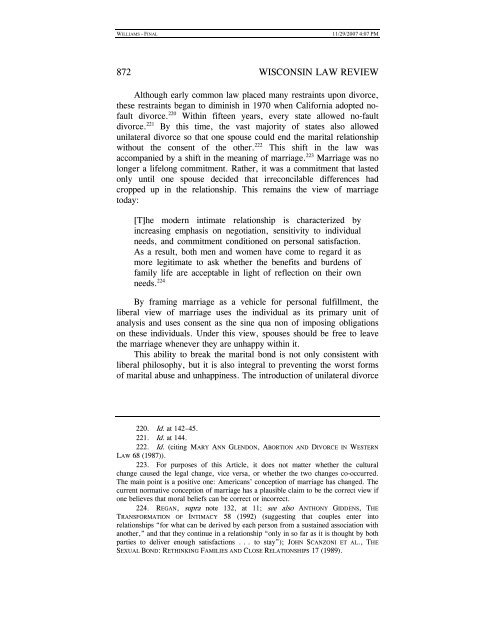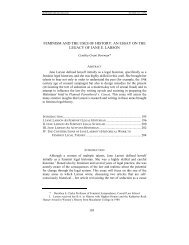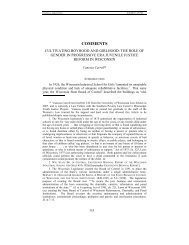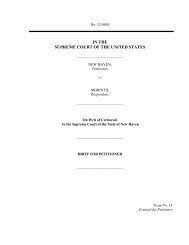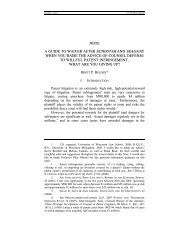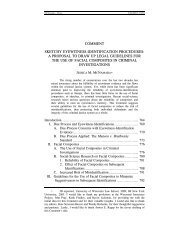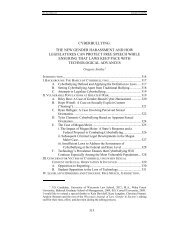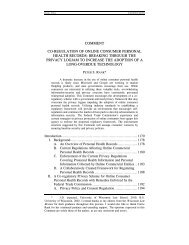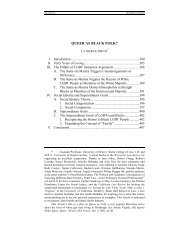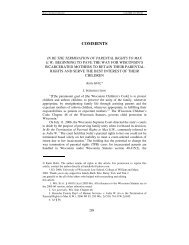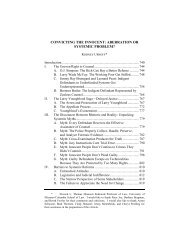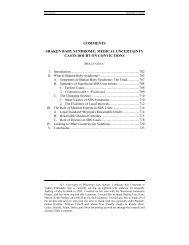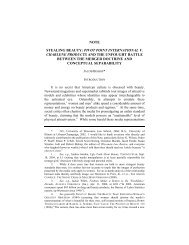POSTNUPTIAL AGREEMENTS - UW Law School
POSTNUPTIAL AGREEMENTS - UW Law School
POSTNUPTIAL AGREEMENTS - UW Law School
You also want an ePaper? Increase the reach of your titles
YUMPU automatically turns print PDFs into web optimized ePapers that Google loves.
WILLIAMS - FINAL 11/29/2007 4:07 PM<br />
872 WISCONSIN LAW REVIEW<br />
Although early common law placed many restraints upon divorce,<br />
these restraints began to diminish in 1970 when California adopted nofault<br />
divorce. 220 Within fifteen years, every state allowed no-fault<br />
divorce. 221 By this time, the vast majority of states also allowed<br />
unilateral divorce so that one spouse could end the marital relationship<br />
without the consent of the other. 222 This shift in the law was<br />
accompanied by a shift in the meaning of marriage. 223 Marriage was no<br />
longer a lifelong commitment. Rather, it was a commitment that lasted<br />
only until one spouse decided that irreconcilable differences had<br />
cropped up in the relationship. This remains the view of marriage<br />
today:<br />
[T]he modern intimate relationship is characterized by<br />
increasing emphasis on negotiation, sensitivity to individual<br />
needs, and commitment conditioned on personal satisfaction.<br />
As a result, both men and women have come to regard it as<br />
more legitimate to ask whether the benefits and burdens of<br />
family life are acceptable in light of reflection on their own<br />
needs. 224<br />
By framing marriage as a vehicle for personal fulfillment, the<br />
liberal view of marriage uses the individual as its primary unit of<br />
analysis and uses consent as the sine qua non of imposing obligations<br />
on these individuals. Under this view, spouses should be free to leave<br />
the marriage whenever they are unhappy within it.<br />
This ability to break the marital bond is not only consistent with<br />
liberal philosophy, but it is also integral to preventing the worst forms<br />
of marital abuse and unhappiness. The introduction of unilateral divorce<br />
220. Id. at 142–45.<br />
221. Id. at 144.<br />
222. Id. (citing MARY ANN GLENDON, ABORTION AND DIVORCE IN WESTERN<br />
LAW 68 (1987)).<br />
223. For purposes of this Article, it does not matter whether the cultural<br />
change caused the legal change, vice versa, or whether the two changes co-occurred.<br />
The main point is a positive one: Americans’ conception of marriage has changed. The<br />
current normative conception of marriage has a plausible claim to be the correct view if<br />
one believes that moral beliefs can be correct or incorrect.<br />
224. REGAN, supra note 132, at 11; see also ANTHONY GIDDENS, THE<br />
TRANSFORMATION OF INTIMACY 58 (1992) (suggesting that couples enter into<br />
relationships “for what can be derived by each person from a sustained association with<br />
another,” and that they continue in a relationship “only in so far as it is thought by both<br />
parties to deliver enough satisfactions . . . to stay”); JOHN SCANZONI ET AL., THE<br />
SEXUAL BOND: RETHINKING FAMILIES AND CLOSE RELATIONSHIPS 17 (1989).


